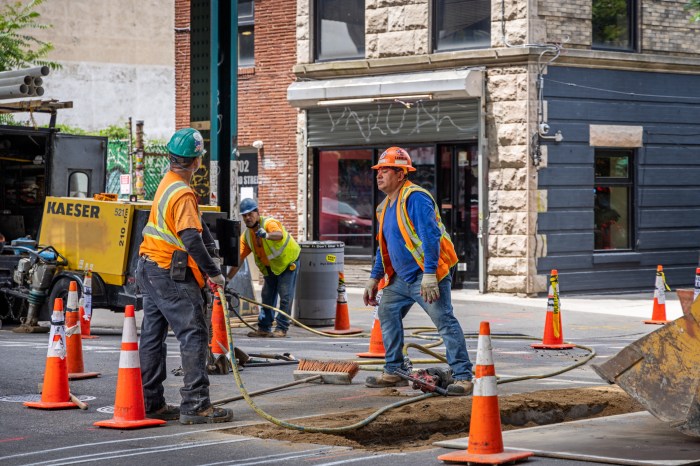
Construction workers in Long Island City. Via Getty Images
April 23, 2025 By Shane O’Brien
Con Edison has kicked off a major infrastructure project in Western Queens as part of efforts to ensure continued reliable electric service in one of the fastest-growing parts of the city.
The Reliable Clean City – Long Island City project, a $125 million investment in a transmission connecting Vernon and Newtown substations in Long Island City, aims to ensure reliability for customers in LIC, Sunnyside, Sunnyside Gardens, Woodside and Hunter’s Point.
The project began on Friday, April 18, and is slated to be completed by the summer of 2026. It will link the Vernon Substation near the LIC waterfront with the Newtown Substation located at 35th Street and 47th Avenue.
The project will start out from Vernon Substation before heading east along 40th Avenue and then turning north on 34th Street. The line will turn east again on 37th Avenue before briefly turning north again on 37th Street. It will eventually move south along 43rd Street after a brief turn east on 34th Avenue before eventually turning west onto 43rd Avenue and linking with the Newtown Substation.

Plans for a transmission line linking Vernon and Newtown substations. Photo: Con Edison
The energy company says the new transmission line—connecting the Vernon and Newtown substations—will significantly boost local power reliability and help meet rising demand from electric vehicles and high-rise buildings.
Once completed, the line will have the capacity to carry 200 megawatts of power, enough to power two million flat-screen televisions or charge 40 million cellphones simultaneously.
The project is part of Con Edison’s broader Reliable Clean City initiative, which last year linked substations in Corona and Long Island City—allowing the utility to shut down an inefficient fossil fuel power plant and improve air quality in the surrounding community.
Con Edison says it is prioritizing transparency throughout the process and has committed to ongoing communication with residents, businesses, elected officials, and community organizations to minimize disruption. To keep the public informed, the company has used construction signage, customer emails, flyers, and other notifications, and has also held meetings with community boards, local leaders, nonprofits, and business groups.
“We’re committed to open dialogue throughout the construction phase to ensure minimal inconvenience to the community,” the utility said in a statement. It added that environmental considerations—including air quality and water protection—will also be factored into the planning and execution.
The project is driven by the accelerating demand for electricity in Long Island City, which has become one of the fastest-growing neighborhoods in Queens. According to Con Edison, increases in electric vehicle adoption and the electrification of newly developed high-rises are pushing local infrastructure toward its current capacity limits.
Con Edison President Matthew Ketschke said the upgrades will help support economic development and modernization throughout the borough.
“Queens residents and businesses can rely on us to support growth, economic development, and the electrification of transportation and buildings across these vibrant neighborhoods,” Ketschke said.
Local leaders have voiced their support, emphasizing the importance of long-term investment in the area’s infrastructure.
Laura Rothrock, president of the Long Island City Partnership, said the project reflects the evolving needs of the community.
“As Long Island City thrives, our energy needs evolve,” Rothrock said. “Con Edison’s infrastructure investment will ensure our community has the power it needs to continue on its exciting path.”
Kenneth Adams, president of LaGuardia Community College, added that the improvements will allow the college to upgrade its own electrical systems.
“This investment will contribute to creating a thriving local economy, with successful businesses of all sizes and plentiful jobs,” Adams said.
Debra Markell Kleinert, district manager of Community Board 2, called the project “imperative” for the neighborhood’s long-term sustainability.
